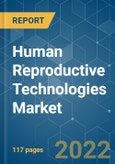The global human reproductive technologies market is anticipated to grow with a CAGR of nearly 2% during the forecast period. Rising prevalence of infertility and delayed family planning is expected to trigger the market growth. As per the US Department of Health & Human Services, one out of 100 couples are facing problem in conceiving, leading to the adoption of reproductive technologies to treat infertility rate which is further triggering the market growth. Moreover, change in lifestyle such as delay in bearing the first child, use of contraceptive pills, increased alcohol consumption and smoking is leading to increasing infertility rates and is providing a significant boost to the market. Growing patient awareness regarding the available technologies for treating problems related to reproduction is projected to increase the adoption of human reproductive technologies. However, Limited Insurance Coverage may restrain the growth of the market.
Key Market Trends
Contraceptive Segment is Expected to Hold a Major Market Share in the Human Reproductive Technologies Market
A contraceptive segment is expected to hold the largest segment owing to oral drugs are the easiest way of contraception in the industry, easy availability of a wide range of products, high awareness about contraceptive drugs and devices and simple mode of administration are the key factors triggering the segment growth. Moreover, increasing incidences of the Sexually Transmitted Disease (STD), an increasing rate of unplanned pregnancies and a rise in government initiatives are also some of the factors propelling the contraceptive drugs and devices segment.
North America Represents the Largest Market and Asia-Pacific is Expected to Register Fastest Growth.
North America is at the forefront of growth in the market studied and is also an important revenue contributor in the global arena. Rise in infertility rates due to high obesity rates, the rising age of conceptions and changes in lifestyle are stimulating the growth of the region. As per the US Department of Health & Human Services, an estimated 10% of women (6.1 million) in the United States are unable to conceive. Moreover, easy access to quality healthcare and favorable reimbursement policies are projected to promote revenue growth in North America.
The Asia Pacific region is likely to post the fastest market throughout the forecast period. The highest population, increasing awareness about reproductive technologies, rapid adoption of western lifestyle has led to the adoptions of these reproductive technologies. In addition, increasing healthcare spending is expected to propel the market in the APAC region.
Competitive Landscape
The Human Reproductive Technologies Market is fragmented in terms of competition and consists of several major players. In terms of market share, few of the major players are currently dominating the market. Some of the companies which are currently dominating the market are CooperSurgical, Inc., Teva Pharmaceutical Industries, AbbVie Inc., Ferring B.V., Merck KGaA, Genea Limited, and Ivftech.
Additional Benefits:
- The market estimate (ME) sheet in Excel format
- 3 months of analyst support
This product will be delivered within 2 business days.
Table of Contents
Companies Mentioned (Partial List)
A selection of companies mentioned in this report includes, but is not limited to:
- CooperSurgical, Inc.
- Teva Pharmaceutical Industries
- AbbVie Inc.
- Ferring B.V.
- Merck KGaA
- Genea Limited
- Ivftech
- Bayer AG
Methodology

LOADING...








